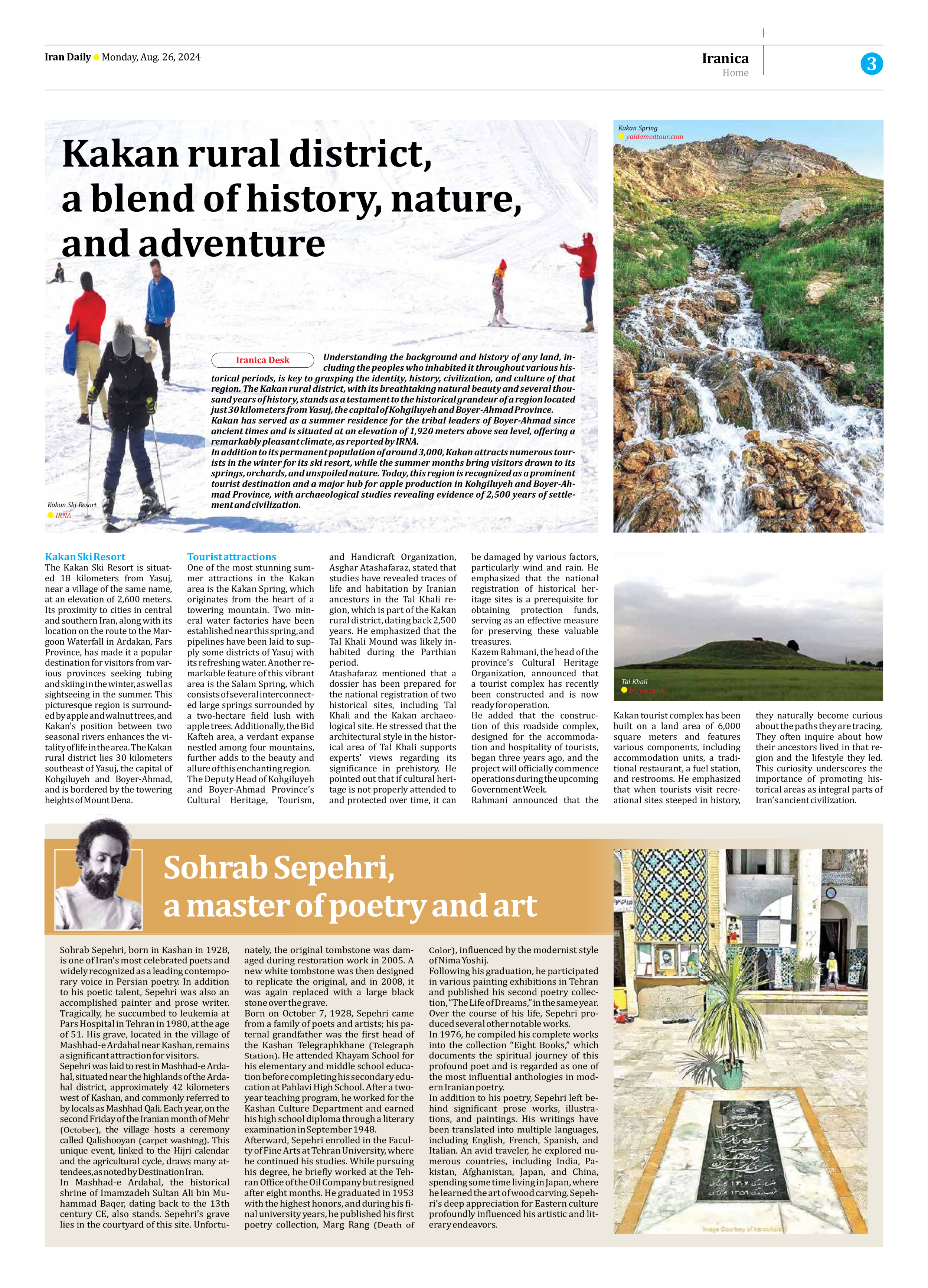
Kakan rural district, a blend of history, nature, and adventure
Understanding the background and history of any land, including the peoples who inhabited it throughout various historical periods, is key to grasping the identity, history, civilization, and culture of that region. The Kakan rural district, with its breathtaking natural beauty and several thousand years of history, stands as a testament to the historical grandeur of a region located just 30 kilometers from Yasuj, the capital of Kohgiluyeh and Boyer-Ahmad Province. Kakan has served as a summer residence for the tribal leaders of Boyer-Ahmad since ancient times and is situated at an elevation of 1,920 meters above sea level, offering a remarkably pleasant climate, as reported by IRNA. In addition to its permanent population of around 3,000, Kakan attracts numerous tourists in the winter for its ski resort, while the summer months bring visitors drawn to its springs, orchards, and unspoiled nature. Today, this region is recognized as a prominent tourist destination and a major hub for apple production in Kohgiluyeh and Boyer-Ahmad Province, with archaeological studies revealing evidence of 2,500 years of settlement and civilization.
Kakan Ski Resort
The Kakan Ski Resort is situated 18 kilometers from Yasuj, near a village of the same name, at an elevation of 2,600 meters. Its proximity to cities in central and southern Iran, along with its location on the route to the Margoon Waterfall in Ardakan, Fars Province, has made it a popular destination for visitors from various provinces seeking tubing and skiing in the winter, as well as sightseeing in the summer. This picturesque region is surrounded by apple and walnut trees, and Kakan’s position between two seasonal rivers enhances the vitality of life in the area. The Kakan rural district lies 30 kilometers southeast of Yasuj, the capital of Kohgiluyeh and Boyer-Ahmad, and is bordered by the towering heights of Mount Dena.
Tourist attractions
One of the most stunning summer attractions in the Kakan area is the Kakan Spring, which originates from the heart of a towering mountain. Two mineral water factories have been established near this spring, and pipelines have been laid to supply some districts of Yasuj with its refreshing water. Another remarkable feature of this vibrant area is the Salam Spring, which consists of several interconnected large springs surrounded by a two-hectare field lush with apple trees. Additionally, the Bid Kafteh area, a verdant expanse nestled among four mountains, further adds to the beauty and allure of this enchanting region.
The Deputy Head of Kohgiluyeh and Boyer-Ahmad Province’s Cultural Heritage, Tourism, and Handicraft Organization, Asghar Atashafaraz, stated that studies have revealed traces of life and habitation by Iranian ancestors in the Tal Khali region, which is part of the Kakan rural district, dating back 2,500 years. He emphasized that the Tal Khali Mound was likely inhabited during the Parthian period.
Atashafaraz mentioned that a dossier has been prepared for the national registration of two historical sites, including Tal Khali and the Kakan archaeological site. He stressed that the architectural style in the historical area of Tal Khali supports experts’ views regarding its significance in prehistory. He pointed out that if cultural heritage is not properly attended to and protected over time, it can be damaged by various factors, particularly wind and rain. He emphasized that the national registration of historical heritage sites is a prerequisite for obtaining protection funds, serving as an effective measure for preserving these valuable treasures.
Kazem Rahmani, the head of the province’s Cultural Heritage Organization, announced that a tourist complex has recently been constructed and is now ready for operation.
He added that the construction of this roadside complex, designed for the accommodation and hospitality of tourists, began three years ago, and the project will officially commence operations during the upcoming Government Week.
Rahmani announced that the Kakan tourist complex has been built on a land area of 6,000 square meters and features various components, including accommodation units, a traditional restaurant, a fuel station, and restrooms. He emphasized that when tourists visit recreational sites steeped in history, they naturally become curious about the paths they are tracing. They often inquire about how their ancestors lived in that region and the lifestyle they led. This curiosity underscores the importance of promoting historical areas as integral parts of Iran’s ancient civilization.







